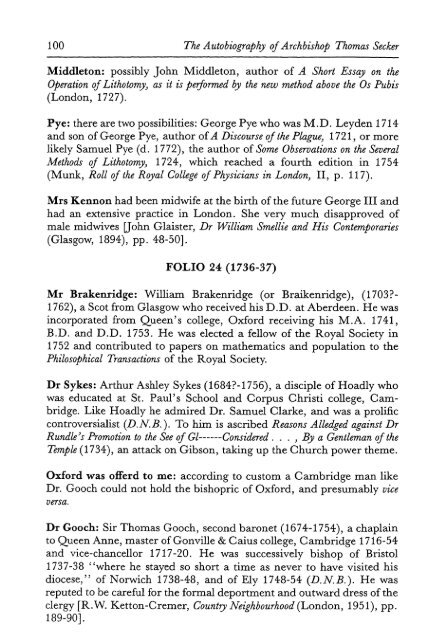Archbishop of Canterbury - KU ScholarWorks - The University of ...
Archbishop of Canterbury - KU ScholarWorks - The University of ...
Archbishop of Canterbury - KU ScholarWorks - The University of ...
You also want an ePaper? Increase the reach of your titles
YUMPU automatically turns print PDFs into web optimized ePapers that Google loves.
100 <strong>The</strong> Autobiography <strong>of</strong> <strong>Archbishop</strong> Thomas Seeker<br />
Middleton: possibly John Middleton, author <strong>of</strong> A Short Essay on the<br />
Operation <strong>of</strong> Lithotomy, as it is performed by the new method above the Os Pubis<br />
(London, 1727).<br />
Pye: there are two possibilities: George Pye who was M.D. Leyden 1714<br />
and son <strong>of</strong> George Pye, author <strong>of</strong> A Discourse <strong>of</strong> the Plague, 1721, or more<br />
likely Samuel Pye (d. 1772), the author <strong>of</strong> Some Observations on the Several<br />
Methods <strong>of</strong> Lithotomy, 1724, which reached a fourth edition in 1754<br />
(Münk, Roll <strong>of</strong> the Royal College <strong>of</strong> Physicians in London, II, p. 117).<br />
Mrs Kennon had been midwife at the birth <strong>of</strong> the future George III and<br />
had an extensive practice in London. She very much disapproved <strong>of</strong><br />
male midwives [John Glaister, Dr William Smellie and His Contemporaries<br />
(Glasgow, 1894), pp. 48-50].<br />
FOLIO 24 (1736-37)<br />
Mr Brakenridge: William Brakenridge (or Braikenridge), (1703?-<br />
1762), a Scot from Glasgow who received his D.D. at Aberdeen. He was<br />
incorporated from Queen's college, Oxford receiving his M.A. 1741,<br />
B.D. and D.D. 1753. He was elected a fellow <strong>of</strong> the Royal Society in<br />
1752 and contributed to papers on mathematics and population to the<br />
Philosophical Transactions <strong>of</strong> the Royal Society.<br />
Dr Sykes: Arthur Ashley Sykes (1684?-1756), a disciple <strong>of</strong> Hoadly who<br />
was educated at St. Paul's School and Corpus Christi college, Cambridge.<br />
Like Hoadly he admired Dr. Samuel Clarke, and was a prolific<br />
controversialist (D.N.B.). To him is ascribed Reasons Alledged against Dr<br />
Rundle :'s Promotion to the See <strong>of</strong> Gl Considered . . . , By a Gentleman <strong>of</strong> the<br />
Temple (1734), an attack on Gibson, taking up the Church power theme.<br />
Oxford was <strong>of</strong>ferd to me: according to custom a Cambridge man like<br />
Dr. Gooch could not hold the bishopric <strong>of</strong> Oxford, and presumably vice<br />
versa.<br />
Dr Gooch: Sir Thomas Gooch, second baronet (1674-1754), a chaplain<br />
to Queen Anne, master <strong>of</strong> Gonville & Caius college, Cambridge 1716-54<br />
and vice-chancellor 1717-20. He was successively bishop <strong>of</strong> Bristol<br />
1737-38 "where he stayed so short a time as never to have visited his<br />
diocese," <strong>of</strong> Norwich 1738-48, and <strong>of</strong> Ely 1748-54 (D.N.B.). He was<br />
reputed to be careful for the formal deportment and outward dress <strong>of</strong> the<br />
clergy [R.W. Ketton-Cremer, Country Neighbourhood (London, 1951), pp.<br />
189-90].

















